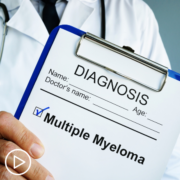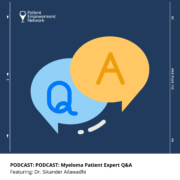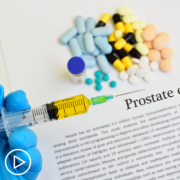Expert Perspective: Advances in Treating Relapsed and Refractory Myeloma
Expert Perspective: Advances in Treating Relapsed and Refractory Myeloma from Patient Empowerment Network on Vimeo.
Dr. Abdullah Khan, of Ohio State University Comprehensive Cancer Center – The James, reviews currently available treatments as well as those in development for patients with relapsed or refractory myeloma.
Dr. Abdullah Khan is a hematologist specializing in multiple myeloma and plasma cell disorders at the Ohio State University Comprehensive Cancer Center – The James. Dr. Khan is also an assistant professor in the Division of Hematology at The Ohio State University. Learn more about Dr. Khan.
See More from Engaging in Myeloma Treatment Decisions
Related Resources:

|

|

|
Transcript:
Katherine:
Are there any recent advances in treatment for patients with relapsed or refractory disease?
Dr. Khan:
Currently and in the past 20 years or so, we’ve seen about 20 approvals for new drugs for patients with multiple myeloma. The way the approval process works it typically looks at the effectiveness of a drug in the relapsed refractory setting first. And after establishing the safety and efficacy, the therapies are moved earlier in the disease course.
The great example of this are the anti-CD38 monoclonal antibodies daratumumab and isatuximab. They were first approved in the relapsed refractory setting in combination with other antimyeloma treatments. And due to their impressive effectiveness and relative safety, they’re already being used in the frontline setting for patients with newly diagnosed multiple myeloma.
In the newly diagnosed setting, a commonly cited study is the phase two GRIFFIN trial. And that added daratumumab to the BRd, or bendamustine (Bendeka, Treanda), lenalidomide (Revlimid), dexamethasone backbone.
And Europe, they completed the phase three study of adding isatuximab, the other anti-CD38 monoclonal antibody to the BRd backbone. And what we’re finding what was very effective in the relapsed refractory setting was actually adding to the efficacy of newly diagnosed treatment regiments. As a side note, these trials – there are also trials looking at daratumumab and isatuximab in the smoldering myeloma phase, so moving it even earlier.
I think one of the most attractive new targets in myeloma is targeting this antigen called B-cell maturing antigen, and a number of therapies are being developed or are already developed for it. The first approved was belantamab mafodotin, and this is an antibody drug conjugate.
So, when the antibody binds to BCMA on the multiple myeloma cells, it releases its toxic payload into the myeloma cell. And so, it’s very effective towards myeloma, and no other good cells or fewer other good cells are affected by it. To provide some numbers, in patients with a median of seven prior lines of treatments, meaning their myeloma had relapsed that many times, the response rate was about 30 percent. And a fifth of those patients had VGPR, very good partial response, or better response.
There are also bispecific antibodies that target this myeloma marker, and we anticipate getting one approved soon in the U.S. called teclistamab. Teclistamab is an antibody that binds both CD3 on T cells of the immune system and B-cell maturating BCMA on the myeloma cells.
So, the way this antibody kills myeloma is by activating the T cells, the immune system, and directly killing the tumor. So, this was recently published in the New England Journal of Medicine. And in people who were treated with at least five prior lines of therapy, the response rate was about 63 percent, and the median progression-free survival, or the time until the myeloma progressed, was about 11 months.
We were very active in a clinical trial looking at the effectiveness of another antibody, a bispecific antibody, called Regeneron 5458. In a similar patient population, the response rates were 75 percent in the higher-dose level group, and right now it’s actually a bit too early to tell how long the progression free survival is or the duration of response.
There are also other bispecifics in development targeting other myeloma markers ssuch as talquetamab, that binds to a marker called GPRC5D, and cevostamab, which binds to a marker called FcRH5. The response rates as single agents in patients with relapsed refractory multiple myeloma are 66 percent and 45 percent respectively. These are all incredible numbers for a single drug in the relapsed refractory setting.










